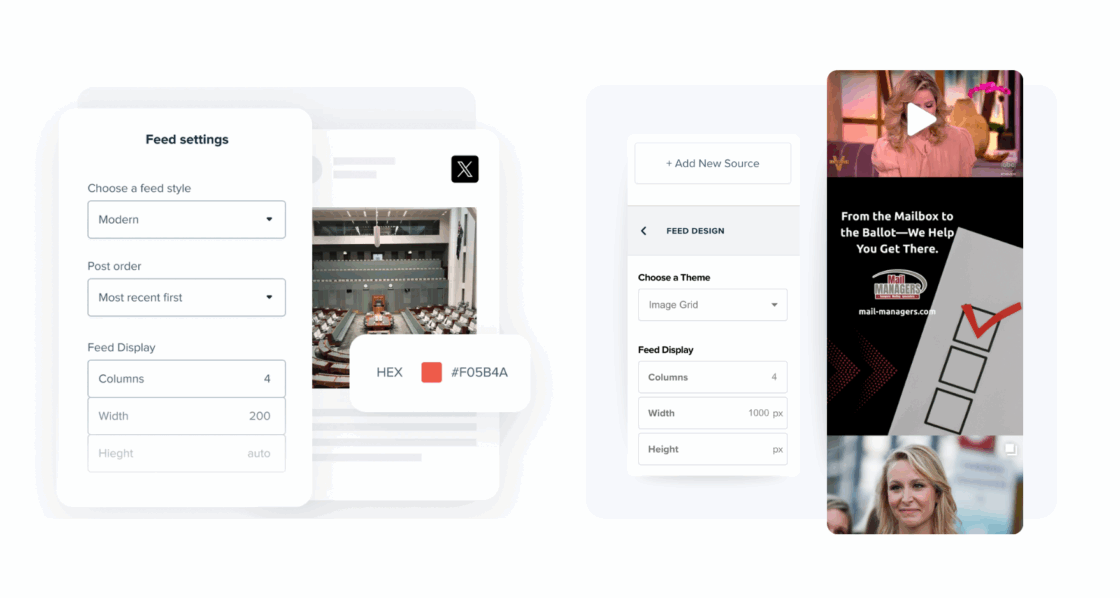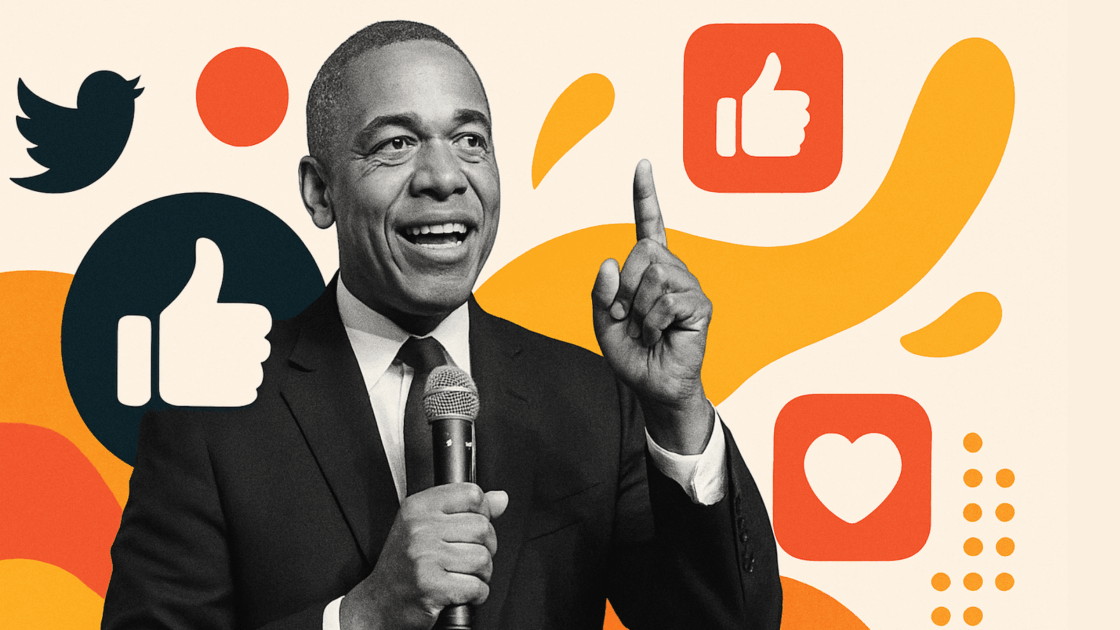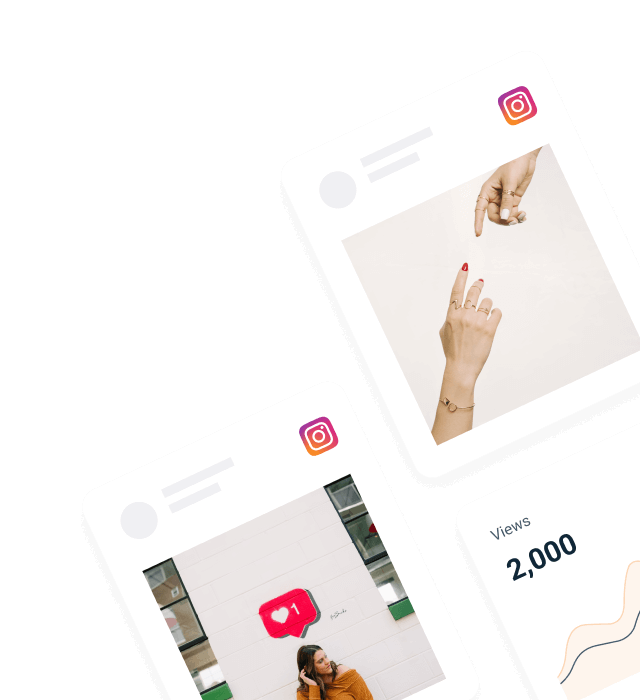28 Tips for Creating a Successful Social Media Political Campaign Strategy
Social media is crucial for candidates and elections in the current political landscape. If handled well, it can win the hearts of the voters, mobilize the support of the people, and generate a dedicated, engaged audience who votes for you. However, if not handled well, one social media mistake could ruin your entire campaign and shatter your dreams.
To help you create an effective political social media campaign strategy, we’ve put together twenty-eight actionable key strategies to guide you from pre-announcement planning through election day and beyond.
Preparing Your Political Campaign Social Media Strategy
A successful political election campaign starts long before the campaign announcement. Here are the key foundations to get your social media political campaign off to a strong start it deserves:
- Create a clear political brand identity. Just like any successful digital marketing campaign, political campaigns need strong branding. Define what makes you different, your main messages, and how you want to position yourself before initiating your campaign on social media. Your brand has to appeal to the audience that you want to reach but must also be true to your political beliefs. Make a style guide with color palettes, font choices, and approved message templates to ensure consistency.
- Hire a dedicated social media team. Build a team with professional experience in content creation, community management, analytics, and crisis management. Even small campaigns need to have team members to manage social accounts, create engaging content, and monitor online conversations and mentions. Modern political campaigns need full-time digital experts to be competitive. For smaller campaigns, you can recruit a part-time social media campaign manager or train volunteers with digital marketing expertise.
- Create a thorough political social media strategy. Develop a detailed roadmap with a content calendar, engagement benchmarks, potential influencer partnerships, and paid social media advertising plans. Your strategy should align with overall campaign objectives and voter outreach goals. Write this plan down to make it consistent within your organization. Have specific metrics for campaign success and regular check-ins to track performance.
- Verify your political social media accounts. With misinformation rampant online, verified accounts give voters confidence that your content is authentic. Request verification badges on major platforms to separate official campaign accounts from possible imposters or parody accounts. This builds trust with your online audience and protects your digital reputation. Start the verification process early since it may take a while to be approved by the platforms.
- Research and understand your target audience. Identify the demographics, interests, problems, and online behaviors of the voters that you wish to target. This will determine on which platforms to prioritize and what content is most effective to enlist potential supporters. Utilize demographic data to build detailed voter profiles for your campaign. Leverage tools like Facebook Audience Insights, Twitter Analytics, and local voter data to craft a detailed profile of your constituents.
- Create a crisis management protocol. Prepare for potential social media controversies or missteps by having clearly laid-out processes for rapid response. Having workflows for handling offending content, negative press, or campaign errors will minimize the damage when issues arise. Every campaign should have designated crisis campaign managers ready to act at a moment’s notice. Create templates for common crisis scenarios to accelerate response times.
- Separate personal and campaign accounts. Create dedicated campaign profiles distinct from the candidate’s personal social media accounts. It keeps things organized and reduces the risk of personal content interfering with campaign messaging. It also creates clear boundaries for campaign staff managing these accounts. Implement a social media policy to define who has access to the accounts and outline approval processes for content.
-
Implement advanced social media monitoring tools. Use social walls and social listening platforms to track:
- Engagement with your political campaign accounts
- Trending topics relevant to your political messaging
- Activity from opposing candidates and campaigns
- Public conversations about your campaign
- Mentions of key policy issues in your jurisdiction
- Questions and concerns from potential voters
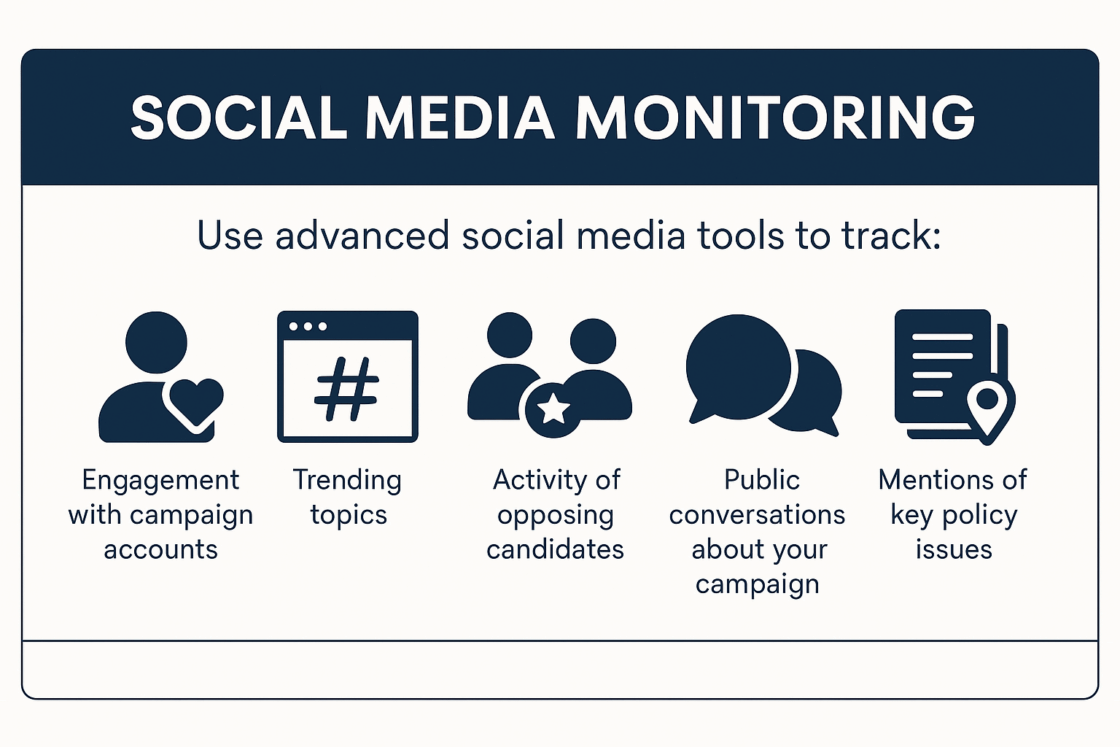
Attention to detail, organizational skills, and a deep understanding of the political landscape are essential for effective campaign setup. A good setup can make the candidate appear trustworthy, generate excitement, and increase the possibility of winning. Having a campaign manager allows you to maintain an aligned message across all platforms. Being transparent, accountable, and receptive to the voters’ demands is most crucial in the campaign setup. Constant monitoring ensures that the campaign remains dynamic and effective.
Creating Effective Content for Your Social Media Political Campaign Strategy
The content you share forms the heart of your social media political campaign. This is how you can make it matter and effectively reach the voters:
- Diversify your platform strategy. Rather than focusing solely on one network, be active where your target voters spend their time. Each platform requires unique strategies, but a multi-channel strategy extends your reach to different demographic segments. Effective political campaigns maintain active profiles across at least 3-4 major digital platforms. Consider each platform’s unique strengths: Facebook for community organizing, Twitter for rapid response, Instagram for visual storytelling, and TikTok for reaching younger voters.
- Create platform-specific messaging. Tailor your content to resonate with your specific target audience segments. The message that works for younger voters on TikTok is quite different from what works for professionals on LinkedIn or community groups on Facebook. Adapt your campaign’s voice but maintain consistent policy positions. Use analytics to build your strategy around high-performing content on each platform.
- Tailor content to each platform’s unique environment. Do not cross-post the same content across all networks. Twitter demands brief, timely messages; Facebook is great at community discussion; Instagram requires strong images; and LinkedIn wants professional, policy-focused content. These differences need to be taken into account in your online strategy. Create platform-specific content calendars to ensure you’re leveraging each network’s unique strengths.
- Invest in high-quality visual content. For visually-oriented digital platforms like Instagram and, to a lesser degree, Twitter, invest in authentic and compelling photos of campaign moments. High-quality images of real events will engage the audience more than stock photos. Think about hiring a professional photographer to cover major campaign events. Build an archive of approved campaign images that your team can have ready when developing content.
- Prioritize video content across platforms. Video usually gets better engagement than text or static images. Create a YouTube channel for longer-form content, such as policy explanations, campaign speeches, and supporter testimonials, but also produce shorter video segments for other platforms. Live streaming events can also boost real-time engagement and create a sense of immediacy and transparency that voters now appreciate.
- Engage with online communities beyond major platforms. Do not ignore forums like Reddit, Discord, and specialized online communities. These websites allow for more policy discussion, voters’ comments, and answers to questions asked by voters in more detailed formats. This approach helps you reach voters who may be less active on mainstream platforms. When the candidate engages in AMAs (Ask Me Anything) sessions, it can be very helpful in building authenticity and trust.
- Use content curation tools for maintaining a consistent posting schedule. Supplement original campaign content with relevant curated content in order to maintain an active presence even during the busiest campaign periods. Social media aggregation tools can help streamline this process and ensure you’re leveraging social media effectively throughout your campaign. Aim for a balance of original content, shared news, supporter spotlights, and behind-the-scenes glimpses of the campaign.
- Focus on meaningful engagement instead of going viral. Going viral will get you more attention, but regular and genuine engagement with your followers builds the strong support that you need to win an election. Responding to messages and comments shows that your campaign values voters’ opinions. Establish a system of ready responses for public inquiries and delegate staff members to actively interact with your constituents.
- Ask your followers for their opinions. Create polls, ask questions, and invite comments to gauge supporter sentiment and identify constituent priorities. This two-way communication shows you are listening and helps sharpen the messages of your campaigns. The information you gather can shape both your online and offline campaign efforts. Use this feedback to address supporter concerns in future content and events.
Growing Your Social Media Political Campaign Audience
Expanding your web presence is crucial for spreading your campaign message and mobilizing voters:
- Activate supporter networks through strategic sharing. Ask campaign supporters to share your message with their networks and families, especially at critical times like campaign launches, fundraising, and voting drives. Offer supporters shareable images and message templates to help them at such times. Create “digital volunteer” programs that recognize and reward supporters who consistently help amplify your message online.
- Integrate social channels across all campaign touchpoints. Add social media links to your campaign site, email signatures, printed materials, and event signage. Display a social media feed on your website showing your latest updates from multiple platforms in one place. This cross-promotion boosts following across all your digital platforms. Consider adding QR codes to printed materials that link directly to your social profiles, making it easy for supporters to find and follow you online.
- Create engagement-driven social contests. Develop social sharing contests that motivate supporters to amplify your message. Photo contests, supporter stories, and volunteer spotlights can help you reach more people and involve more supporters. These activities create a sense of community around your campaign. User-generated content not only helps you reach more people but also provides real testimonials from actual supporters, which is a very compelling type of evidence.
- Develop strategic partnerships with aligned social media influencers. Partner with respected community leaders, issue advocates, and personalities who share your campaign’s values and can authentically introduce your candidate to new audiences. Influencer partnerships can help expand your reach to new, previously untapped segments and increase voter engagement. Prioritize authentic relationships over transactional endorsements—voters can spot a fake from a mile away.
- Use targeted advertising to reach specific groups of voters. Platform advertising tools allow pinpoint targeting based on geography, interests, and demographics. Use them to reach undecided voters and strategic areas with messages that address their specific issues. Even small ad budgets can be effective if used strategically to reach key groups of voters with customized messages. Transparency, accountability, and compliance with election laws and regulations are critical in political advertising.
- Use real-time updates in live events. Utilize formats like Twitter threads, Instagram Stories, and Facebook Live to provide instant updates from campaign events, debates, and community activities. Real-time information helps people feel included and helps those who cannot be physically present. Assign team members to cover different aspects of live events to create comprehensive real-time coverage.
Measuring and Optimizing Your Political Campaign Social Media Strategy
To maximize the effectiveness of your digital marketing political campaign, monitor how well it is running and adjust your strategy:
- Set clear KPIs for your social media performance. Define key metrics that support your campaign goals, including engagement rate, follower growth, website traffic from social media, volunteer sign-ups, and donation conversions. These metrics are clear indicators of campaign success. Set up a dashboard to monitor these metrics over time and spot trends and areas for improvement.
- Conduct regular competitive analysis. Monitor what your competitors are doing on social media platforms to be able to determine opportunities and threats. Knowing how other campaigns engage with voters can help strengthen your own approach. Take note of what types of content and messages stick with your common audience.
- Test different content formats and messages. Use A/B testing to see which content types your audience responds to best. Use what you learn to continuously improve your content strategy as the campaign progresses. Don’t be afraid to experiment with new formats and platforms as they become available—being an early adopter is often a benefit with high rewards.
- Allocate resources based on platform performance. Spend more time and money on the social medoa platforms that are performing the best for your campaign goals. Be ready to shift from low-performing platforms if needed. Keep adjusting your platform plan according to data analysis and changing voter behavior.
- Analyze the timing of your posts for maximum impact. Find out when your fans are most online and post your content around those times. Posting at the best time can significantly increase engagement and reach. Use platform analytics to see your audience’s peak activity hours and experiment with posting at different times to find the sweet spot.
Organize Your Social Media Political Campaigns with Juicer
It is challenging to keep up with multiple social media accounts in the middle of a busy campaign season. Juicer allows you to seamlessly aggregate all your social media posts into one master feed that can be displayed on your campaign website or digital displays at campaign headquarters. This enables voters to see all your content in one place, giving them a complete picture of your campaign message and activity.
With Juicer’s social media aggregator, you can:
- Aggregate content from multiple social media platforms into a single, cohesive feed
- Filter content to showcase the most relevant posts
- Customize the display to fit your political campaign branding
- Update your website automatically when new social content is published
- Give supporters an overview of your campaign’s online presence.
- Get your campaign more noticed online without requiring additional staff hours.
- Use digital screens to make events more exciting.
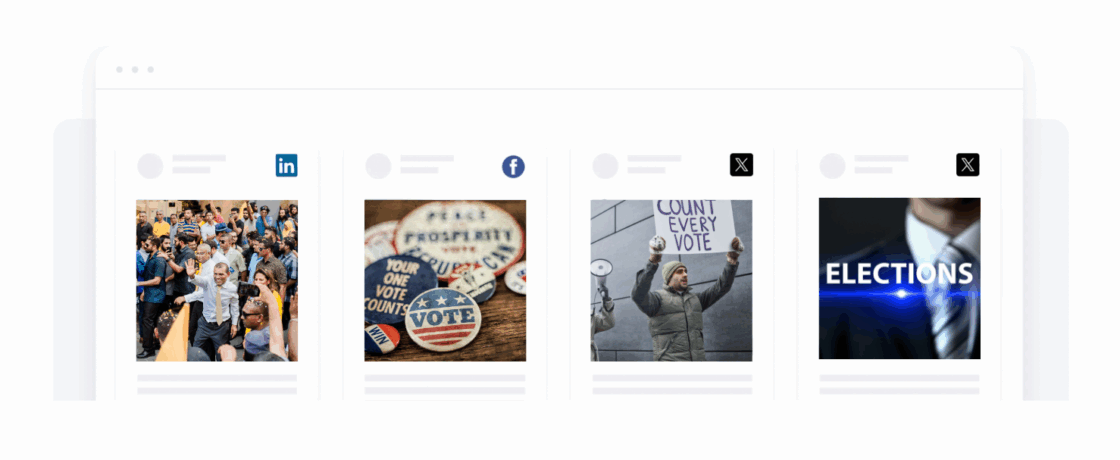
Juicer simplifies managing your social media presence, allowing your team to focus on what matters most—creating great content instead of spending hours manually updating your website. By integrating your social media efforts, you build a more integrated digital presence that supports the core messages of your campaign.
Additional Resources for Political Campaign Social Media Success
To further enhance your political campaign’s social media strategy, we recommend checking out these valuable external resources:
- Pew Research Center: Social Media and Politics – Research-backed insights into how Americans use social media to engage with political campaigns
- Federal Election Commission: Internet Communication Disclaimers – Official guidelines on required disclaimers for political content online
- Sprout Social’s Political Social Media Index – Data-driven analysis of political engagement across social media platforms
- HootSuite’s Political Campaign Playbook – Useful advice for managing social media during political campaigns
- Facebook’s Guide for Political Campaigns – Platform-specific best practices from Facebook
Want to simplify your campaign’s social media management and create a more impactful online presence? Try Juicer for free today and learn how our tools can transform your campaign’s online efforts in minutes, without code or technical expertise. Our user-friendly dashboard allows you to display your campaign’s social feeds on your own site with just a few clicks.
